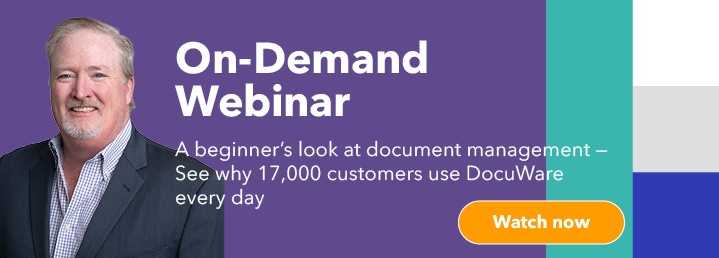Sometimes, the terms document management system (DMS) and content management system (CMS) are interchangeably. That’s understandable, because the two solutions have some of the same capabilities. When you take a closer look, you’ll find that they solve completely different business problems.
What causes the confusion?

Document management and content management systems both:
- Manage and securely store digital assets.
- Enable content creation, retention and distribution.
- Provide a centralized repository and securely store information.
- Tag content with a unique identifier to enable flexible search and easy retrieval.
- Provide advanced information security through authentication, permissioned access, encryption and audit logs.
- Support sharing of information that improves collaboration.
- Enable the creation of automated workflows.
Business process automation vs. digital asset creation and management
.jpg?width=600&height=400&name=Wooden%20blocks%20create%20a%20workflow%20chart%20on%20pink%20background%20(1).jpg)
| A DMS: | A CMS: |
|
|
|
|
|
|
|
|
|
|
|
|
|
|
|
|
How do you know if you need a DMS or a CMS?

Now that you understand the basic differences between these two software platforms, it’s time to figure out which one you need.
Choose a DMS if you want:
- A central repository that categorizes, stores and retrieves business documents, video and audio files, photographs and CAD drawings and other formats.
- Automated workflow to speed up business processes and save time and money.
- A flexible solution that can scale as your business grows.
- Permissioned access, authentication and protection against cyberthreats to ensure customer and employee data privacy.
- Your teams to create and collaborate on processes and projects such as invoice processing, performance reviews, contracts, quality control and order processing using features including workflow, e-signature, version control and an audit trail.
- Backup capabilities to support business continuity and disaster recovery.
Choose a CMS if you want to:
- Create and publish web content and/or create a website on an easy-to-use platform.
- Add video and images to these web pages
- Use a graphical user interface (GUI) that enables non-technical users to edit, publish and manage content without programming experience.
- Automate workflows to coordinate marketing and advertising campaigns and provide outreach for customer relationship management.
As you can see, a DMS and a CMS serve very different purposes. Creating automated workflows, providing powerful search, integrating with other business software, offering e-signatures and the creation of eforms, and improved regulatory compliance are among the most important functions of document management. While a CMS is designed for the creation, organization, storage, and retrieval of published content. Larger organizations may need both solutions, but most companies find that one of them meets their particular business requirements.
Learn more about document management.




